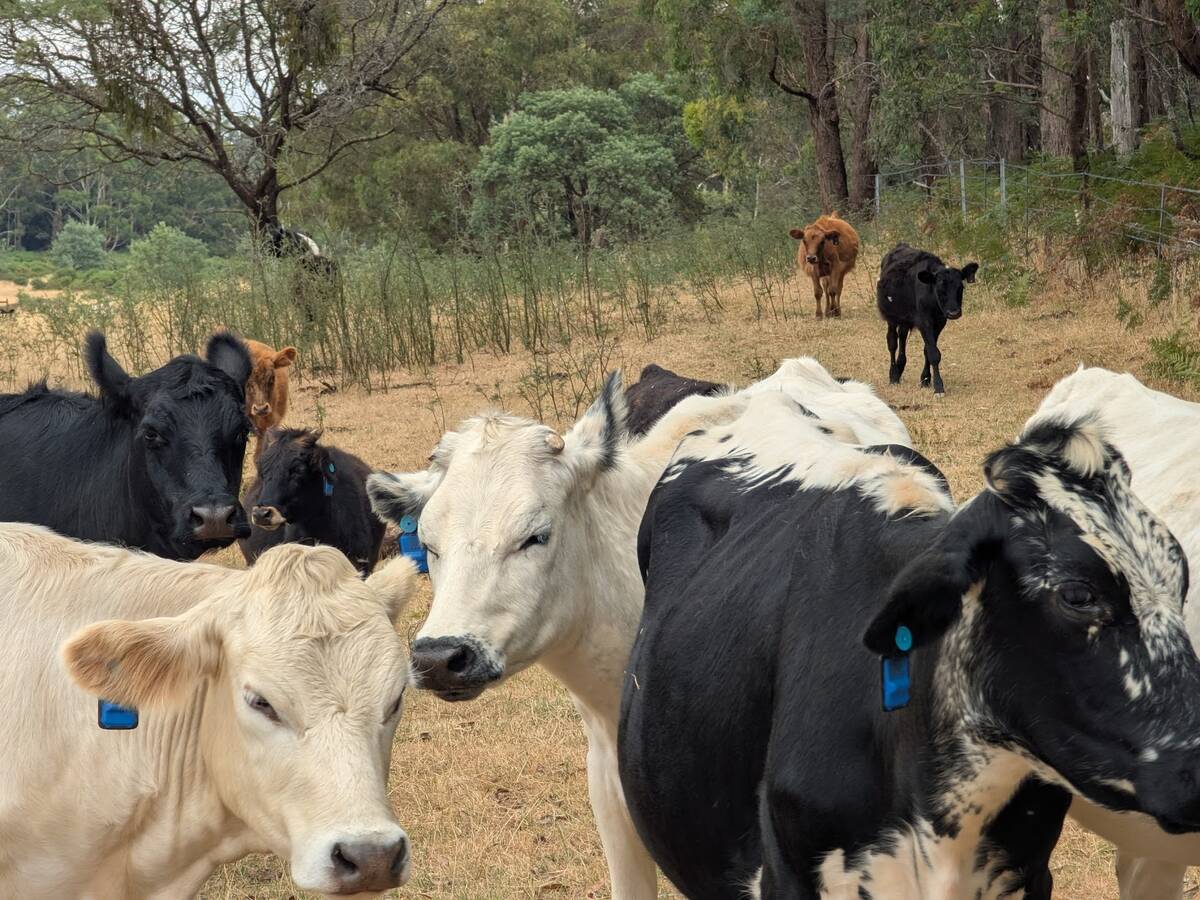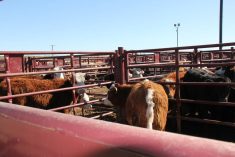When Lee Sinclair would come home from college and university in the summers, he worked at feedlots, which is where his interest in low-stress cattle handling started. “Nobody had ever told me position, distance and angles make the difference. All we were taught is, we’ve got to get this done,” Sinclair said. “So you use your horse as a tool or a hockey stick or a sorting stick or whatever it is, and now we can get it done. But how much pressure and how much stress are we putting on those cattle?”
Sinclair grew up as a town kid in Lloydminster, Sask., but spent much of his time around livestock and on farms, thanks to his family and friends, as well as through his father and grandfather, who both worked hauling livestock. Sinclair would tag along with them, flying down a Prairie highway, where he became acquainted with ranches, auction marts, feedlots and packing plants. He was exposed to the animal health side of things after his father took a job as a pen rider when Sinclair was in his early teens.
As a child, Sinclair started competing in rodeo, where he rode steers, then moved to the saddle bronc competition. He attended Lakeland College where he competed on the rodeo team, then attended Montana State University on a rodeo scholarship, where he obtained his degree in animal science. He has spent much time since retiring from rodeo helping the next generation of cowboys and cowgirls learn the sport.
Read Also

Australian company brings ear-tag tech to Canadian pastures
With Smart Paddock, beef farmers and ranchers can track their cattle through GPS technology
It was during his time at post-secondary that he began working summers at the feedlot and began seriously considering how cattle were worked.
“I realized there’s got to be a better way to do this,” Sinclair said. “As I’m riding pens, my job is to find sick animals. If you ask the pen rider, ‘What’s your job?’ ‘Well, I find sick animals.’ Well, that’s kind of a self-fulfilling prophecy in a sense. If we handle those cattle wrong, well, we make sick cattle. So, what I’ve learned is we’ve got to shift our mindset.”
Now, Sinclair works for Merck Animal Health and tries to teach producers and industry professionals the benefits of low-stress cattle handling.
Low-stress handling origins
Low-stress cattle handling, more commonly known simply as stockmanship, is a method of handling cattle that ensures it keeps the animal’s stress levels low, rather than elevating them. It has not yet become widely used. However, it’s a personal pillar for the people who implement it.
According to the Government of Manitoba’s website, low-stress cattle handling is based on the knowledge of the cattle’s natural instincts and “on an awareness of an animal’s point of balance, its field of vision and its flight zone.”

Bud Williams is well-known among people who are passionate about stockman- ship and is often referenced as one of the founders of the practice. Born in 1932 in southern Oregon, Williams spent his life perfecting his stockmanship method and teaching others how to do it. His method of stockmanship consisted of learning how to “read” the cattle and changing your position to make the cattle want to go where you tell them to go.
Now, Williams’s version of stockmanship has slowly been adopted by a variety of different professionals, as well as organizations such as Merck Animal Health.
Stockmanship
When it comes to low-stress cattle handling, Sinclair said it’s important to understand where the animal’s stress is coming from.
In a feedlot scenario, with cattle ending up in a new place they’ve never been before and not knowing where the water is, where the feed is, and are surrounded by unfamiliar animals, stress is unavoidable.
“Those calves are like… a grade nine kid going to high school. He’s not going to walk down the grade 12 hallway. And now he’s thrown in there with all these different kids. So how do we take that stress off?”
However, things can be done to mitigate some of this stress. Sinclair said in a feedlot setting, the most important thing when new cattle arrive is to make sure they get fed, watered and rested as soon as possible. Creating a low-stress environment with stockmanship can help with this.
Merck Animal Health has many videos on this topic on its website, known as “Creating Connections,” which aims to help teach you the methods of stockmanship and to educate on the benefits it can have on cattle health (see link to the Creating Connections video page at bottom). They have videos for feedlot, cow-calf and stocker operations. Soon, they’ll have resources for dairy operations as well.
The “Acclimation” video series is geared towards feedlots. It demonstrates how to acclimate new cattle to their new surroundings to ensure they get fed, watered, and are resting as quickly as possible.
In the video, they say giving the cattle small lessons, around three to seven minutes, of acclimation each day will help them settle in quickly and trust the water source and the environment more.
Sinclair echoes this, as getting the cattle comfortable helps overall with their health. He said when using stockmanship practices, one of the first things you should do is find the sensitive animals, or the cow that has her head up. This is a sign that this cow doesn’t trust you. Sinclair said you should take note of that animal as you work the cattle because usually, she leads the herd, and if she takes off, she will take all of the cattle with her.
“She’s telling us we are too close and we need to stop,” Sinclair said. “And we might need to change our body position — so take our eyes off of her and change our body position. This might be 10 seconds, and that might be enough to just get her to lower her head, then we can proceed, but now we’re going at a different angle. So every time we see that head come up, we have to shift our angles.”
He said one of the issues people run into is they focus too much on those sensitive cows and rile them up. Instead, they should be aware of those types of animals, but use them to help herd the rest of the group.
Sinclair said one of the most important things to learn in this type of stockmanship is how to read the body language of the cattle.
“We’re aware of what she’s doing. But I can change my position, distance and angles to gain her trust because she is a leader. We can use her to lead the rest of the animals, but I’ve got to get her calmed down first.”
Animal health
Stockmanship has been proven to benefit the health of the animals, as well.
Sinclair said the main thing with animal health is the cattle start eating and drinking as soon as possible.
“If I get them hydrated, if I get some feed into them, now I’m starting to get production. It’s all about production. We’ve got to get pounds on them. Now, as an animal health company, if I get them hydrated, my vaccines are going to work better. I need those cells to be hydrated to pick up those antigens from the vaccine to work. Then, if she’s eating, and my implant is in there, I need nutrients or water to drive that implant as well and build muscle.”
Merck’s website states stockmanship works best preventively, rather than as a reaction to already-ill cattle. Low-stress cattle handling prevents injury and improves immunity. Instead of feedlot pen riders and employees responding to ill or lame cattle, they are working ahead of time to ensure those cattle don’t get sick to begin with.
Sinclair said low-stress cattle handling also helps with the safety and health of employees. When cattle are less stressed and less riled up, employees are less likely to get injured or frustrated on the job.
Forget the stick
For producers who may be interested in learning how to implement low-stress cattle handling practices on their operation, one of Sinclair’s biggest tips is to make sure you don’t have anything in your hands.
“As guys, we’re bad,” Sinclair said. “If we have something in our hand, we’re probably going to use it, and we’re going to overuse it. So, that stick allows us to put more pressure on, whereas when we have to use just our body with no extra stick, now it makes us slow down and think a little more about what we’re doing.”
He said if producers want to go more in-depth, they should check out the Creating Connections page on Merck’s website, at creatingconnections.info/videos.
Stockmanship at Shipwheel Cattle Feeders
Andrea Stroeve-Sawa of Shipwheel Cattle Feeders learned stockmanship from the man himself — Bud Williams.
Her father had met Williams at a conference in the U.S. and invited Williams to come to their place in Alberta. Stroeve-Sawa said her father and Williams would work cattle together for two weeks straight, 12 hours a day, with Williams teaching him all the ins and outs of stockmanship.
And oftentimes, Stroeve-Sawa was out there with them, as well.
“I remember Bud teaching me how to sort cattle… And so that was kind of my first introduction to proper stockmanship. And then from there, Dad completely pivoted how we were doing things. And from then on, I learned by osmosis, just by being around it.”
Stroeve-Sawa is the fourth generation of her family to manage Shipwheel Cattle Feeders Ltd., located in Taber, Alta. Currently, Shipwheel consists of a yearling grazing program and a 5,500-head feedlot, as well as some cropland, bees and pasture-raised chickens.
Stroeve-Sawa has been involved with stockmanship since she was 10, and now as manager of Shipwheel, she implements those management practices into the operation.
“We really make an effort continually to be working towards getting better at what we’re doing when we’re handling cattle,” she said.
“I would say that we’re never really done. Even myself, I’m still learning and growing and trying to get better.”
She said she’s seen some of the benefits of stockmanship when it comes to animal health.
“And we’ve seen the difference that it can make to things like feed efficiency and how fast we can get calves on feed and it just makes all the difference,” Stroeve-Sawa said.
“Even in humans, or in cattle, when we get stressed, that causes an increase in cortisol to go through our body. So how do we stop that? We as humans would do whatever self-care we need to do… those calves don’t know how to do that. So we have to assist them, and so if we don’t assist them, the negative cycle of stress just continues.”
Stroeve-Sawa said there are challenges with implementing this practice on their feedlot, however. She said it’s hard to find people to hire who know what stockmanship is, or are willing to learn and implement the practice.
This is why she said she doesn’t know if stockmanship will ever become widely practiced, despite its benefits. For many people who use this method, it’s not just a management practice — it’s integral to their operation.
“It’s tough, like a lot of these bigger places, where you have 20 or 30 staff, how do you get them all trained to a level where they could actually do that? It’s tough, it’s not an easy thing. And it really has to start from the top.
“Your staff has to implement it properly, and so they have to be committed, and in order for them to be committed, you have to be committed… It almost becomes a belief within your place.”

















